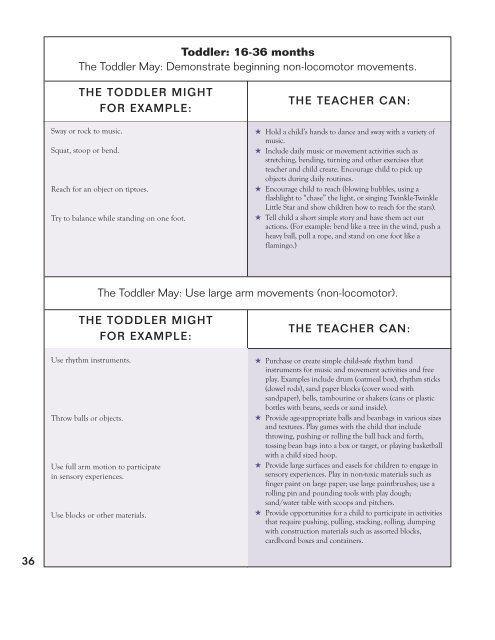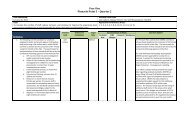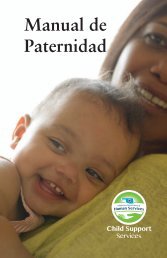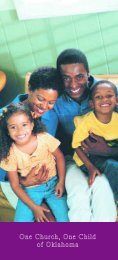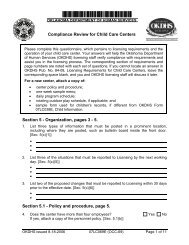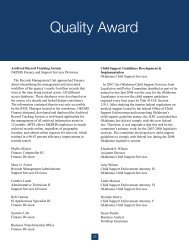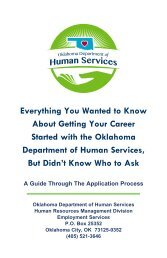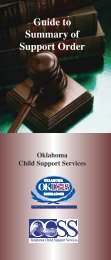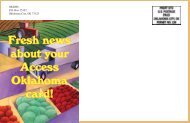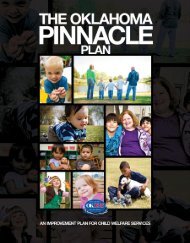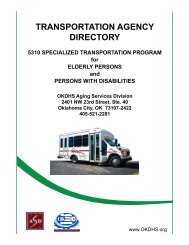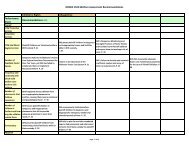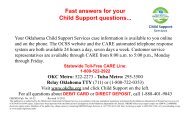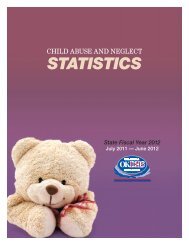Oklahoma Early Learning Guidelines for Infants, Toddlers and Twos
Oklahoma Early Learning Guidelines for Infants, Toddlers and Twos
Oklahoma Early Learning Guidelines for Infants, Toddlers and Twos
You also want an ePaper? Increase the reach of your titles
YUMPU automatically turns print PDFs into web optimized ePapers that Google loves.
36<br />
Toddler: 1636 months<br />
The Toddler May: Demonstrate beginning nonlocomotor movements.<br />
THE TODDLER MIGHT<br />
FOR EXAMPLE:<br />
Sway or rock to music.<br />
Squat, stoop or bend.<br />
Reach <strong>for</strong> an object on tiptoes.<br />
Try to balance while st<strong>and</strong>ing on one foot.<br />
THE TEACHER CAN:<br />
★ Hold a child’s h<strong>and</strong>s to dance <strong>and</strong> sway with a variety of<br />
music.<br />
★ Include daily music or movement activities such as<br />
stretching, bending, turning <strong>and</strong> other exercises that<br />
teacher <strong>and</strong> child create. Encourage child to pick up<br />
objects during daily routines.<br />
★ Encourage child to reach (blowing bubbles, using a<br />
flashlight to “chase” the light, or singing TwinkleTwinkle<br />
Little Star <strong>and</strong> show children how to reach <strong>for</strong> the stars).<br />
★ Tell child a short simple story <strong>and</strong> have them act out<br />
actions. (For example: bend like a tree in the wind, push a<br />
heavy ball, pull a rope, <strong>and</strong> st<strong>and</strong> on one foot like a<br />
flamingo.)<br />
The Toddler May: Use large arm movements (nonlocomotor).<br />
THE TODDLER MIGHT<br />
FOR EXAMPLE:<br />
Use rhythm instruments.<br />
Throw balls or objects.<br />
Use full arm motion to participate<br />
in sensory experiences.<br />
Use blocks or other materials.<br />
THE TEACHER CAN:<br />
★ Purchase or create simple childsafe rhythm b<strong>and</strong><br />
instruments <strong>for</strong> music <strong>and</strong> movement activities <strong>and</strong> free<br />
play. Examples include drum (oatmeal box), rhythm sticks<br />
(dowel rods), s<strong>and</strong> paper blocks (cover wood with<br />
s<strong>and</strong>paper), bells, tambourine or shakers (cans or plastic<br />
bottles with beans, seeds or s<strong>and</strong> inside).<br />
★ Provide ageappropriate balls <strong>and</strong> beanbags in various sizes<br />
<strong>and</strong> textures. Play games with the child that include<br />
throwing, pushing or rolling the ball back <strong>and</strong> <strong>for</strong>th,<br />
tossing bean bags into a box or target, or playing basketball<br />
with a child sized hoop.<br />
★ Provide large surfaces <strong>and</strong> easels <strong>for</strong> children to engage in<br />
sensory experiences. Play in nontoxic materials such as<br />
finger paint on large paper; use large paintbrushes; use a<br />
rolling pin <strong>and</strong> pounding tools with play dough;<br />
s<strong>and</strong>/water table with scoops <strong>and</strong> pitchers.<br />
★ Provide opportunities <strong>for</strong> a child to participate in activities<br />
that require pushing, pulling, stacking, rolling, dumping<br />
with construction materials such as assorted blocks,<br />
cardboard boxes <strong>and</strong> containers.


